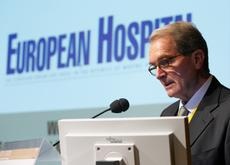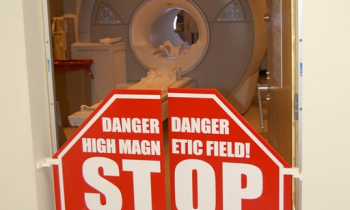"Hospitals are expected to improve their performance continually"
Management Section
By Rob Skelding
A series of expert presentations organised by European Hospital in cooperation with the ECR addressed the latest issues affecting hospital management, information technology and fincance and attracted more than 400 attendees. Click here to read the summary of the five Management speeches.

Management
Niall Dickson, chief executive of a London-based charitable organisation and think-tank, the King’s Fund, captured the challenge of running a European hospital in today’s environment: “it’s like sitting the cockpit flying a plane, except the control wires are crossed – you take one action, and something else happens you weren’t expecting”.
In this climate of reduced healthcare budgets, increasing numbers of patients and an aging (expensive to treat) population, hospitals across Europe are feeling increased pressure to perform – and to measure that performance effectively.
“Why is hospital performance important?” asked Dickson. “Europe spends a lot of money on healthcare – it counts for the largest part of the GDP spend in many OECD countries. However, with falling budgets, fewer beds and more patients requiring hospital care, there is immense pressure on performance and efficiency.”
The key drivers of this pressure are, he said:
- The aging population (more ‘very old’ people living for longer with co-morbidities and dementia, increasing social care as well as medical costs)
- Current lifestyles (sedentary, diet and smoking)
- Disease profiles (cancer has become a chronic disease as well as an acute condition)
- Society’s expectations (people don’t accept perceived disinterest or poor, inconvenient service by the healthcare system)
- Medical innovation (increases costs)
- IT advances (increases costs)
- Health inequalities
- Workforce demands better work/life balance (EU Working Time Directive limits doctors’ hours).
Measuring performance
Using the English healthcare system (NHS) as an example, Dickson suggested several measures to deal with the ‘target-driven society’. These include government targets (to reduce waiting lists etc) plus new targets (patient-reported outcome measures, reduced cancer deaths etc).
To answer these challenges, he suggested hospital/healthcare managers should:
- Take ‘hard decisions’ in this new low-money/high-demand era)
- Avoid short-termism (do not remove management tiers)
- Redesign services to be more efficient
- Value clinical leadership
- Focus on hospital services – not buildings
“With the right approach, it is possible to do more for less,” he concluded.
What does a successful hospital look like?
This question was posed by Stefan Furtmüllelr, Manager of Vienna-based Contrast Management Consulting, who discussed key findings from an Austrian study to define best practice and top priorities in hospital management. He also identified areas for improvement, adding that the conclusions could be applied in many European countries.
His study asked successful hospital managers to define ‘success’, and prioritise the results:
- Patient satisfaction
- High-quality medical/clinical results
- Employee satisfaction
- Financial success
- Area-wide provision of services
- Motivation of employees
- A good image (public relations and reputation)
- High utilisation of hospital capacity
With regard to which stakeholders were considered as the ‘most influential’, results revealed ‘hospital (or group) owners’ as the most prominent, followed by ‘employees’ and ‘patients’. The following four positions comprised (in descending order of influence) ‘politicians’, ‘internal lobbies’, ‘external lobbies’ and ‘media/public’.
Hospitals in Europe are under increasing pressure to economise and create efficiencies, yet without compromising patient care or organisational operations – indeed, they are expected to improve their performance continually.
His study produced several notable findings regarding ‘perceptions versus reality’ in the quality of European hospital management, shedding light on areas for improvement:
(Strategic management)
(93% of hospitals have a documented strategy… but only 40% implement it comprehensively
60% review their strategy… but only 26% apply measurement criteria
(Control)
90% use basic cost accounting… but only 27% are able to specify real ‘costs per service’
1 in 2 hospitals surveyed has a short-term planning service… but just 1 in 4 has systematic medium-term planning
Management reports are offered at every hospital… but only 13% are tailored to give the right information in the best way
(Process/quality management)
73% have clearly defined responsibilities… but only 20% define or review these targets
Nearly 3 in 4 hospitals measure patient satisfaction… but only 1 in 4 assess the objective data
Across all hospitals surveyed, just 20% have a bespoke quality management system.
“Overall, 90% of hospital managers expect rising needs for change due to increasingly limited resources and the changing age and demand structure in the population,” Furtmüller commented. “The fields where action is required most urgently are: demand for services, quality management and continual improvement and growth.”
He concluded that creating synergies – across medical care, service functions, integration with external suppliers and management tools and techniques – will enable hospitals to weather the economic storm
“Approaches should aim to be systematic, comprehensive, and related clearly to the needs of stakeholders.”
A new hospital design
Few people in Europe are lucky enough to gain the opportunity to entirely redesign and relocate their hospital’s diagnostic imaging unit; a chance to maximise service quality and efficiency using the most innovative approaches, while boosting financial performance and minimising service waste.
David Wormald, assistant vice-president, St Joseph’s Health Care, at McMaster University in Hamilton, Canada, embraced the prospect when it arose, using lean management to recreate a cutting-edge facility around the patient experience at St Joseph’s – a multi-site hospital serving 1.4 million people.
Lean management maximises organisational efficiency, deploying resources principally to create value for the end ‘customer’ (ie, the patient and their family, plus hospital employees).
Through a collaboration with GE Healthcare’s ‘hospital of the future’ specialists, Wormald implemented a redevelopment project that would see clinical efficiency increase by 54% and patient ‘travel’ become 80% more efficient. It also improved patient and employee satisfaction, and optimised several key quality, risk and safety issues.
Innovations include the use of natural light, noise reduction, ‘warm’ materials, easy navigation and a dedicated patient information concierge. Every design decision was informed by ‘lean’ evidence-based principles, involving all stakeholders, to create an ambiance that reduced anxiety and boosted satisfaction.
“The diagnostic imaging department went through a complete transformation process and is now well positioned to cater for future demands,” he told delegates at European Hospital’s ECR 2009 symposium.
“From a financial perspective, the lean management approach enabled us to find around $300k in time saving and increased our operating performance.”
Achieving accreditation and ‘excellent standards’
Quoting the Greek philosopher Aristotle – “Excellence is not an act, it’s a habit” – Dr Leonardo la Pietra, chief medical officer at the European Institute of Oncology (IEO) in Milan, Italy, added a note that for hospital groups in Europe, “accreditation is (at its core) a risk reduction activity.”
Conceived as a “comprehensive cancer centre”, the IEO is a private, not-for-profit group within the Italian national healthcare system, which has become recognised internationally for its high standards and quality record.
Like many hospitals, the IEO has always published its financial performance data. But in 2002, a change in its approach to international benchmarking brought in a new model for monitoring performance. Subsequently, in 2004, it began publishing its first authorised reports on quality.
In 2007, the IEO received a hospital benchmarking trophy, which Dr la Pietra explained was “awarded for outstanding best practices in care and treatment”.
He also described how for organisations to become accredited by the International Joint Commission on standards, as is the IEO, they must comply with the international patient goals:
1.Identify and diagnose patients correctly
2.Improve effective communications
3.Enhance safety of high-alert medicines
4.Eliminate ‘wrong site, wrong patient, wrong procedure’ incidents
5.Reduce the risk of hospital acquired infections.
He added that ‘excellent standards in European healthcare’ demand:
Patient care
Patient safety
Government leadership and direction
Facility management
Overall safety and security for staff
Employee qualifications, education and recruitment
Management of communications/information
Building a new hospital in Vienna
Based on a talk by Dr Wilhelm Marhold, Director of the Vienna Hospital Association
Challenge:
To change the structure of Vienna’s hospital provision to:
deliver top-level medicines to every patient (not just those who can afford to pay)
build new structures to enhance clinical services
change the culture of Vienna’s hospital administration
Scenario:
Vienna has many hospitals, but they are located mainly in the ‘old’ (Western) part of the region. The city is expanding Eastwards and therefore requires a better ‘balance’ of services. Medicine has advanced hugely, but hospital management has not kept pace.
Method: Build a new hospital in the North-East, and close down several other units (and sections within units that remain) within the KAV group of 12, in the old part of Vienna.
Concept: “Of course, changing the structure like has financial challenges. But we do not wish to sell our hospitals or patients to the private sector, as it more common in Germany. We simply want to transfer our medical services,” said Dr Marhold.
Comments: “What we need is to combine medicine and economy, and then we have a great chance for the progress made in medicine over the years to come through the new structures of management in our organisations. Medicine and the economy are like two fruits, and I think if we combine them they will taste good.”
09.03.2009











